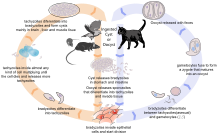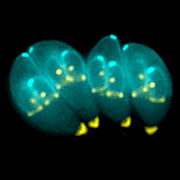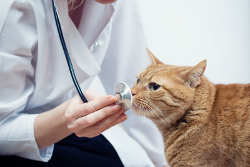Feline Toxoplasmosis is a parasitic disease that affects cats (and also humans). The disease is caused by a single-celled parasite known as Toxoplasma Gondii. The parasite has been known to affect and cause most of the parasitic diseases in almost every warm blooded animal. Although the parasite is very common in cats, it rarely causes serious condition in them. The cats mostly act as a primary host to the parasites; they pass the parasite through feces. The disease can be passed from cats to human beings.
In cats, the parasite’s reproductive form lives in the small intestines and the infective oocysts (thick-walled spore able to survive for lengthy periods outside a host) leaves their body through feces. The oocysts become infective within the first 5 days. They can live in the natural environment for years as they are highly resistant to disinfectants. On consumption of the infected prey, the parasite is released into the cat’s intestine again and it cycle starts again.
How do cats get Toxoplasmosis?
The main source of the infection in cats is eating uncooked meat from an infected prey. Since kittens’ immunity has not yet fully developed, they are likely to experience serious symptoms of the disease than the cats. The cats that hunt in the wild are more prone to contract the disease than those living in our homes as pets. This is because pets are more hygienic than the wild cats and in many cases they feed on cooked meals.
Feline Toxoplasmosis cycle
 Toxoplasma Gondii’s life cycle comprises two main stages; these are the sexual and asexual phases. During the former, the tissue cysts is ingested by a cat after consuming an infected rodent. The cysts then thrive in the cats intestines for 3 to 10 days.
Toxoplasma Gondii’s life cycle comprises two main stages; these are the sexual and asexual phases. During the former, the tissue cysts is ingested by a cat after consuming an infected rodent. The cysts then thrive in the cats intestines for 3 to 10 days.
They are later egested via the bowels and join the asexual phase; in the outer world. If a human being comes into contact with a host cat’s feces, they may acquire the parasite. As a matter of procedure, the cyst then resumes the sexual phase. The cycle goes on like that in a repeated manner.
Causes and symptoms of Feline Toxoplasmosis
Cats are infected by toxoplasmosis due to consumption of oocysts. The oocysts are mostly present in the tissues of chronically infected preys such as rodents and birds. It is rare for a mature cat to show symptoms of the disease; however the cats which have less immunity can show the following clinical symptoms
- Lethargy/ Tiredness
- Loss of appetite
The disease can also affect the feline’s liver, lungs and nervous system. Kittens that are exposed to the disease in their mother’s womb are mostly likely to show the above symptoms when they grow up.
Can people get feline toxoplasmosis?
 Yes. People who come to contact with the feces of infected cats are mostly likely to contract the disease. People with weak immune systems are more likely to be affected by the disease. Fortunately, most of the people have contracted the disease and developed strong immunity to it. Some of the symptoms that indicate a human being has got the disease are:
Yes. People who come to contact with the feces of infected cats are mostly likely to contract the disease. People with weak immune systems are more likely to be affected by the disease. Fortunately, most of the people have contracted the disease and developed strong immunity to it. Some of the symptoms that indicate a human being has got the disease are:
- Hepatitis
- Diarrhea
- Inflammation
- Depression
- Partial or total blindness
- Increased pulse rate
- Muscle pain
If you suspect that your can has the disease, it is advisable to take the cat to the veterinarian for it to be diagnosed. Toxoplasmosis is mostly diagnosed under the basis of the pet’s medical history or the sign of its infection after a test has been done to the cat.
The test involves a routine blood test. The veterinarian can also perform diagnostic test like ocular examination, feces examination, complete blood count, IgM antibody test and IgG, fluid analysis and Cerebrospinal.
Sometimes the oocysts can be found in the feces but this is not sufficient to confirm that the cat is suffering from Toxoplasmosis. This is because the parasite looks like other parasites. In order to make the right diagnosis, the veterinarian does a microscopic examination of the cat’s tissues.
Cats that are capable of shedding oocysts should by quarantine for treatment. They should be kept away from other pets, children and pregnant mothers so as to prevent the spread of the parasite.
Is there a cure for feline toxoplasmosis?
Although there is no drug that can kill the parasite, there veterinarian uses antibiotics to clear up most of the disease symptoms. The treatment of toxoplasmosis involves a course of antibiotics known as Clindamycin. The veterinarian can also use a combination of sulfonamides and pyrimethamine to treat the disease.
These drugs inhibit the parasites from reproducing. It is very important for your cat to stay on medication after it has been diagnosed with the disease and continue taking the drugs even after the symptoms have diminished. The veterinarian my also offer home medications that should be strictly followed so that the medication can work effectively.
Feline Toxoplasmosis Prevention tips
Like any other disease, it is wise to prevent toxoplasmosis. Some of the preventive measures you can use to prevent both the cat and human beings from acquiring the parasite are:
- Proper prevention requires the pet keeper to properly train his/her pets.
- The cat should only feed on dry or cooked food. Uncooked meat, bones and entrails should be completely avoided as tissues from these foods may contain oocysts.
- Trash and garbage containers should be kept away or enclosed in order to prevent garbage scavenging by the cats.
- Never allow your cat to go hunting for wild mice and birds
- Wear protective cloth when gardening.
- Take proper hygienic protection when handling raw meat.
- Pregnant mothers should avoid cleaning the litter box as it may contain oocysts.
- Use disposable rubber gloves while cleaning the litter bin
- Do not eat uncooked meat
- Cover the child’s sand box if he/she is not playing with it. This is done to prevent the cat from defecating in it.
It is not necessary to go to extreme measure if your pet is diagnosed with toxoplasmosis. By practicing good hygiene and treating your cat, both the cat and you can stay safe and live a healthy life. To sum it up, toxoplasmosis is a rather dangerous disease however it can be easily contained if one takes prompt steps to visit a vet.
Thanks for visiting www.catdandruffclinic.com, if you liked this article please like us using the side bar .
Related Posts:



Comments are closed.